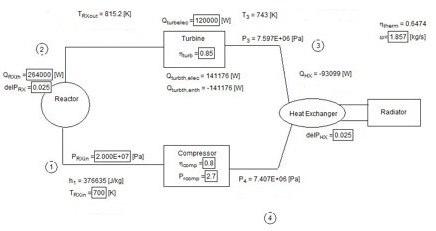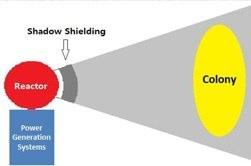The Extra-Planetary Space Reactor group has created a comprehensive design for an electric power production system on Mars, based around a nuclear reactor. This reactor system will produce 120 kW of electric power, enough to sustain a 24-person Mars colony. The reactor itself will be a supercritical carbon dioxide-cooled fast reactor, utilizing 20% enriched uranium nitride fuel in a beryllium oxide matrix. A 19-by-19 square matrix of square fuel elements, 2 cm on each side, will have holes drilled through each fuel element for coolant flow. The square matrix will be surrounded by a cylindrical beryllium oxide reflector, which in turn is surrounded by a 6-cm thick pressure vessel. The total core radius (including pressure vessel) is 45 cm, and the core height is 60 cm. The power conversion system will be a single-loop Brayton cycle, again utilizing supercritical carbon dioxide as a working fluid. The thermal-hydraulic cycle is fairly simple, containing only the reactor, turbine-generator pair, a compressor, and a heat exchanger which will bring waste heat to a radiator. The radiator utilizes liquid-metal heat pipes to wick the waste heat away from the system. Overall, the system operates at an impressive efficiency of 42.22%, requiring 264 kW of thermal power production from the core. The core inlet temperature will be 700K, and the core outlet temperature will be 815K. Finally, the system will utilize a shadow-shielding system to protect the Mars colony from the radiation produced by the reactor. The shadow shield protects only a certain solid angle from the radiation, and is being used to save mass in the total system. A combination of boron-ethylene (for neutron protection) and tungsten (for gamma protection) will make up the shielding, and Mars soil may also be utilized for additional protection. The shield will limit the radiation dose level to 50 mrem/hr at a distance of 3 meters from the reactor. This comprehensive design is meant to operate at full power for 8 years between refueling or replacement, and the total system mass is approximately 5 metric tons (5,000 kg). The team believes that this design could be an important preliminary stepping stone in mankind’s journey to Mars.
Team: Dimitri Mata, Eric Baker, Storm Veunephachan, Sungwook Choi
Project Advisor: Dr. Wei Ji

The thermodynamic cycle for the proposed reactor plant
Project Motivation
The thermodynamic cycle for the proposed reactor plant As humans pursue the urge to further explore the other planets within our solar system and seek to travel beyond the reaches of our solar system, a hard truth begins to emerge: solar power requires a star to be nearby for the production of electricity. This is not the only downside; NASA is looking to establish a self-sustaining human colony on Mars and the month-long dust storms that block out the sun and cover everything in dust on Mars make it dangerous to rely solely on solar power production. One solution to this need for electrical power generation is the use of a small, “lightweight” nuclear reactor that can be moved using equipment capable of operating in these harsh environments.

A simple Layout of the reactor plant in relation to the colony
Project Description
A simple Layout of the reactor plant in relation to the colony The Extra-Planetary Space Reactor group has created a comprehensive design for an electric power production system on Mars, based around a nuclear reactor. This reactor system will produce 120 kW of electric power, enough to sustain a 24-person Mars colony. The reactor itself will be a supercritical carbon dioxide-cooled fast reactor, utilizing 20% enriched uranium nitride fuel in a beryllium oxide matrix. A 19-by-19 square matrix of square fuel elements, 2 cm on each side, will have holes drilled through each fuel element for coolant flow. The square matrix will be surrounded by a cylindrical beryllium oxide reflector, which in turn is surrounded by a 6-cm thick pressure vessel. The total core radius (including pressure vessel) is 45 cm, and the core height is 60 cm. The power conversion system will be a single-loop Brayton cycle, again utilizing supercritical carbon dioxide as a working fluid. The thermal-hydraulic cycle is fairly simple, containing only the reactor, turbine-generator pair, a compressor, and a heat exchanger which will bring waste heat to a radiator. The radiator utilizes liquid-metal heat pipes to wick the waste heat away from the system. Overall, the system operates at an impressive efficiency of 42.22%, requiring 264 kW of thermal power production from the core. The core inlet temperature will be 700K, and the core outlet temperature will be 815K. Finally, the system will utilize a shadow-shielding system to protect the Mars colony from the radiation produced by the reactor. The shadow shield protects only a certain solid angle from the radiation, and is being used to save mass in the total system. A combination of boron-ethylene (for neutron protection) and tungsten (for gamma protection) will make up the shielding, and Mars soil may also be utilized for additional protection. The shield will limit the radiation dose level to 50 mrem/hr at a distance of 3 meters from the reactor. This comprehensive design is meant to operate at full power for 8 years between refueling or replacement, and the total system mass is approximately 5 metric tons (5,000 kg). The team believes that this design could be an important preliminary stepping stone in mankind’s journey to Mars.